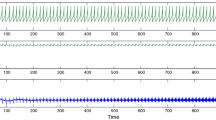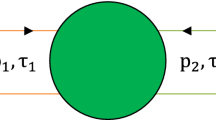Abstract.
The space-lumped two-variable neuron model is studied. Extension of the neural model by adding a simple synaptic current allows the demonstration of neural interactions. The production of synchronous burst activity in this simple two-neuron excitatory loop is modeled, including the influence of random background excitatory input. The ability of the neuron model to integrate inputs spatially and temporally is shown. Two refractory periods after stimuli were identified and their role in burst cessation is demonstrated. Our findings show that simple neural units without long-lasting membrane processes are capable of generating long lasting patterns of activity. The results of simulation of simple background activity suggest that an increase in background activity tends to cause decreased activity of the network. This phenomenon, as well as the existence of two refractory periods, allows for burst cessation without inhibition in this simple model.
Similar content being viewed by others
Author information
Authors and Affiliations
Additional information
Received: 6 December 1996/Accepted in revised form: 7 April 1997
Rights and permissions
About this article
Cite this article
Kudela, P., Franaszczuk, P. & Bergey, G. A simple computer model of excitable synaptically connected neurons. Biol Cybern 77, 71–77 (1997). https://doi.org/10.1007/s004220050368
Issue Date:
DOI: https://doi.org/10.1007/s004220050368




